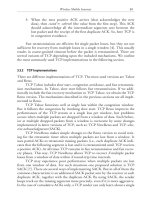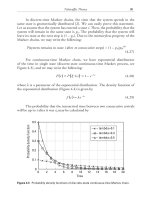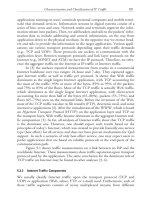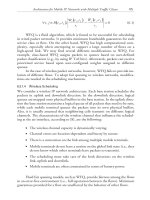Artech house interference analysis and reduction for wireless systems jan 2003 ISBN 1580533167 pdf
Bạn đang xem bản rút gọn của tài liệu. Xem và tải ngay bản đầy đủ của tài liệu tại đây (5.42 MB, 428 trang )
TE
AM
FL
Y
Interference Analysis and Reduction
for Wireless Systems
For a listing of recent titles in the Artech House Mobile Communications Series,
turn to the back of this book.
Interference Analysis and Reduction
for Wireless Systems
Peter Stavroulakis
Artech House
Boston • London
www.artechhouse.com
Library of Congress Cataloging-in-Publication Data
Stavroulakis, Peter.
Interference analysis and reduction for wireless systems / Peter Stavroulakis.
p. cm. — (Artech House mobile communications series)
Includes bibliographical references and index.
ISBN 1-58053-316-7 (alk. paper)
1. Radio—Interference. 2. Cellular telephone systems—Protection. I. Title.
TK6553 .S715 2003
621.382’24—dc21
2002038273
British Library Cataloguing in Publication Data
Stavroulakis, Peter.
Interference analysis and reduction for wireless systems. — (Artech House mobile
communications series)
1. Wireless communication systems 2. Electromagnetic interference
I. Title
621.3’845
ISBN 1-58053-316-7
Cover design by Yekaterina Ratner
Figures 2.1, 2.8, 2.9, 2.10, 2.12, 4.10, 4.11, 4.12, 4.13, 4.19, 4.21, and 4.22 1999. Reprinted by permission
of John Wiley & Sons, Inc., Antennas and Propagation for Wireless Communication Systems, by S. R. Saunders.
Figures 2.4, 2.6, and 2.7 2000. Reprinted by permission of John Wiley & Sons, Inc., The Mobile Radio
Propagation Channel, by J. D. Parsons.
Figures 3.13, 3.16, 3.17, and 4.14–4.16, 2000. Reprinted by permission of John Wiley & Sons, Inc., Digital
Communication over Fading Channels, by M. K. Simon and M. S. Alouini.
Figure 5.17 2001. Reprinted by permission of John Wiley & Sons, Inc., Wireless Local Loops, Theory and
Applications, by P. Stavroulakis.
Figures 6.13–6.15 2000. Reprinted by permission of John Wiley & Sons, Inc., Advanced Digital Signal
Processing and Noise Reduction, by S. V. Vaseghi.
2003 ARTECH HOUSE, INC.
685 Canton Street
Norwood, MA 02062
All rights reserved. Printed and bound in the United States of America. No part of this book
may be reproduced or utilized in any form or by any means, electronic or mechanical,
including photocopying, recording, or by any information storage and retrieval system, without
permission in writing from the publisher.
All terms mentioned in this book that are known to be trademarks or service marks have
been appropriately capitalized. Artech House cannot attest to the accuracy of this information.
Use of a term in this book should not be regarded as affecting the validity of any trademark
or service mark.
International Standard Book Number: 1-58053-316-7
Library of Congress Catalog Card Number: 2002038273
10 9 8 7 6 5 4 3 2 1
Besides my parents, two institutions have fundamentally affected my life,
career, and philosophy: my high school in Crete and my alma mater,
New York University. In these institutions, four teachers played a major role
and I respectfully dedicate this book to them. These are my teachers Andreas
Maragakis and Christos Makris and my professors Mohammed Ghaussi and
Philip Sarachik.
Contents
Preface
References
xv
xviii
Acknowledgments
xix
1
Overview of Wireless Information Systems
1
1.1
1.1.1
Introduction
Wireless World Evolution
1
2
1.2
Historical Perspective
4
1.3
First Generation Systems
4
1.4
Second Generation Systems
4
1.5
1.5.1
1.5.2
Third Generation Systems
UMTS Objectives and Challenges
Standardization of UMTS
9
10
12
1.6
1.6.1
1.6.2
1.6.3
1.6.4
The Cellular Concept
Frequency Reuse
Handover/Handoff Mechanism
Cell Splitting
Types of Cellular Networks
13
14
17
18
18
vii
viii
Interference Analysis and Reduction for Wireless Systems
1.7
1.7.1
Satellite Systems
Mobile Satellite Systems
20
26
1.8
Wireless Local Loops
29
1.9
1.9.1
WLANs
The HIPERLAN System
30
30
1.10
Wireless Data Networks
39
1.11
Wireless Broadband Mobile Communication
Systems
41
1.12
Millimeter Waves
43
1.13
Other Wireless Communications Systems
References
44
44
2
Wireless Channel Characterization and
Coding
47
2.1
Introduction
47
2.2
2.2.1
2.2.2
The Wireless Communication Channel
Path Loss
Multipath Propagation
48
51
55
2.3
2.3.1
2.3.2
2.3.3
Channel Coding
Interleaving
Channel Coding Fundamentals
Types of Codes
References
72
72
73
74
82
3
Transmission Systems in an Interference
Environment
85
3.1
Introduction
85
3.2
Analog Transmission
86
Contents
ix
3.3
3.3.1
3.3.2
Analog Modulation Methods
Amplitude Modulation
Angle Modulation
88
89
90
3.4
Noise and Interference in Analog
Transmission
Interference
Noise
92
93
97
3.4.1
3.4.2
3.5
Comparison of Modulation Systems Based on
Noise
100
3.6
Digital Transmission
102
3.7
3.7.1
3.7.2
3.7.3
Digital Modulation Techniques
Linear Modulation Techniques
Nonlinear Modulation Techniques
Spread Spectrum Systems
104
107
119
123
3.8
BERs and Bandwidth Efficiency
130
3.9
3.9.1
3.9.2
3.9.3
3.9.4
3.9.5
3.9.6
3.9.7
Access Techniques
FDMA
TDMA
CDMA
FDD
TDD
Comparison of FDD and TDD
Orthogonal Frequency Division Multiplex
References
132
134
134
135
145
145
146
148
153
4
Optimal Detection in Fading Channels
155
4.1
Introduction
155
4.2
Received Signal Conditional Probability
Density Function
156
Interference Analysis and Reduction for Wireless Systems
Average BER Under Fading
160
4.4
4.4.1
4.4.2
4.4.3
Flat Fading Compensation Techniques
Nonpilot Signal–Aided Techniques
Pilot Signal–Aided Techniques
Diversity Techniques
165
167
168
175
4.5
4.5.1
4.5.2
Frequency Selective Fading
Equalizers
A Comparison of Frequency Selective Fading
Compensation Algorithms
References
192
195
207
209
5
Interference Analysis
213
5.1
Introduction
213
AM
FL
Y
4.3
TE
x
5.2
5.2.1
5.2.2
5.2.3
5.2.4
5.2.5
Types of Interference
Cochannel Interference
Adjacent Channel Interference
Intermodulation Interference
Intersymbol Interference
Near End to Far End Ratio Interference
214
214
221
223
228
239
5.3
5.3.1
5.3.2
Interference Analysis Methodology
Analog Signals
Digital Signals
References
241
243
249
272
6
Interference Suppression Techniques
275
6.1
Introduction
275
6.2
6.2.1
6.2.2
6.2.3
6.2.4
Interference Reduction/Mitigation
Indirect Reduction Methods
Direct Reduction Methods
Distortion Mitigation
Nonlinear Methods
276
277
288
292
304
Team-Fly®
Contents
xi
6.3
6.3.1
6.3.2
6.3.3
6.3.4
Interference Avoidance
SIR Optimization Via Interference Avoidance
Interference Avoidance for Multiple Users
Capacity and Total Square Correlation
Iterative Methods of TSC Reduction
References
316
316
320
320
322
324
7
Applications
329
7.1
Introduction
329
7.2
Interference-Canceling Equalizer for Mobile
Radio Communication
Configuration of Interference-Canceling
Equalizer
7.2.1
7.3
331
331
A Linear Interference Canceler with a Blind
Algorithm for CDMA Systems
Configuration and Operation of a Linear
Interference Canceler
335
7.4
7.4.1
Indirect Cochannel Interference Canceler
Configuration of the Receiver
340
340
7.5
7.5.1
Adaptive Interference Canceler
Configuration of the Canceler
342
343
7.6
Intersymbol Interference and Cochannel
Interference Canceler Combining Adaptive
Array Antennas and the Viterbi Equalizer in a
Digital Mobile Radio
344
System’s Configuration
345
7.3.1
7.6.1
7.7
7.7.1
7.8
7.8.1
335
Hybrid Interference Canceler with Zero-Delay
Channel Estimation for CDMA
347
HIC
347
Cancellation of Adjacent Channel Signals in
FDMA/TDMA Digital Mobile Radio Systems 351
Receiver’s Configuration
351
xii
Interference Analysis and Reduction for Wireless Systems
7.9
7.9.1
7.9.2
Adaptive Multistage PIC
PIC
Adaptive Multistage PIC
References
354
354
355
359
Appendix A: Signal and Spectra in Wireless
Communications
361
A.1
A.1.1
Physically Realizable Waveforms
Energy and Power Waveform
361
365
A.2
Orthogonal Series Representation of Signals
and Noise
Orthogonal Functions
Orthogonal Series
Fourier Series
Line Spectrum for Periodic Waveforms
366
366
367
368
370
A.2.1
A.2.2
A.2.3
A.2.4
A.3
A.3.1
A.3.2
Fourier Transform and Spectra
Sampling Theorem
Parseval’s Theorem and Energy Spectral
Density
PSD
References
375
376
377
Appendix B: HMMs—Kalman Filter
379
B.1
HMMs
379
B.2
Parameters of an HMM
381
B.3
B.3.1
HMM—Kalman Filter Algorithm
Problem Formulation
381
381
B.4
Maximum A Posteriori Channel Estimates
Based on HMMs
Notation
382
384
A.3.3
B.4.1
372
374
Contents
B.4.2
B.4.3
B.4.4
B.4.5
B.4.6
xiii
Estimation Objectives
Spread-Spectrum Signal Estimator Using
Recursive HMMs
Transition Probabilities
Levels of the Markov Chain
Observation Noise
References
384
385
388
389
389
391
About the Author
393
Index
395
Preface
The subject of interference in communications systems is as old as communications itself. Agamemnon, the King of Mycenes, who captured Troy more
than 800 miles away, to get back his niece, the beautiful Eleni, and wanted
to notify his wife Clytaemistra about this happy event, used the most sophisticated communication techniques of that time to achieve his purpose. From
that time until today, people have been aware of the importance of interference and the effect it can have on communications. Agamemnon used light
sources at the peaks of mountains—by the motions of these sources, the
information was coded and transmitted from mountain to mountain to
arrive at Mycenes the same day.
If we analyze this communication system of Agamemnon, we find that
he used three of the most important techniques still used today for interference
suppression in communications. The first was the nature and form of the
information signal (certain shape of flame), which corresponds to signal
modulation techniques of today. The motion of the flames corresponds to
modern coding techniques. The use of mountains corresponds to channel
estimation techniques, which are used for the exploitation of favorable channel propagation characteristics or the avoidance of unfavorable characteristics
through compensation of certain propagation parameters, fading, narrowband, or wideband characteristics.
Over the more than 3,000 years since Agamemnon, the necessary
coexistence of information and interfering signals has been accommodated
in the design of communication systems. Modern mathematical modeling
and simulation techniques as new tools of study greatly facilitated this effort.
xv
xvi
Interference Analysis and Reduction for Wireless Systems
Of course, the subject of interference received special attention each time
people concentrated on the usage of wireless systems on a large scale, as
during the decade of 1970–1980 with the implementation of satellite systems
and from 1995 until today with the large-scale applications of mobile systems.
Most results of the worldwide efforts that had to do with interference analysis
and design have been included in [1] and [2]. The purpose of this book is
to present and analyze the techniques that are being used and can be used
in the design of modern wireless systems in order to achieve an acceptable
quality of service in an interference environment. Of course, many things
have changed since Agamemnon and the early satellite implementations and
special communication systems used during early space exploration. It is
absolutely certain that the communications world is becoming digital, the
wireless systems are converging into a universal standard, and the interference
analysis and suppression techniques have become highly sophisticated because
they have to be applicable to a universal communication system. As such,
the material in this book becomes more and more comprehensive, from
Chapter 4 on, and the reader—who can be an instructor, researcher, practicing engineer or a student—must have had a course in communication, signal
processing or probability, and stochastic process in order to get the most
out of it. The structure of this book is based on the methodology adapted
by the author to present the subject matter of the book.
It is assumed that the reader will not have any difficulty proceeding
along the steps that are formatted by the chapters that follow. Even though
the interference signals (sources) and the general interference environment
are discussed in Chapters 4 and 5, we shall briefly explain here in general
terms the main theme of interference. As we shall see later, Chapters 4
through 7 introduce and analyze the subject of interference in detail.
For the readers who are not familiar with this subject, as far as this
book is concerned, there exist two types of interfering signals no matter
what their source is. One type is an additive signal, which enters the receiver
and affects the detection process. Its source and nature can be a signal from
a noiselike source, a signal from another friendly or nonfriendly system, or
a signal produced by the nonlinearities of the system itself and its components
(such as filters, which are exhibited as intermodulation signals and/or
intersymbol interference). The other kind of interfering signals are the multiplicative types, which are mainly produced because of multipath phenomena
in wireless systems, as we shall see in Chapter 4.
Before we embark on the main theme of this book, we consider it
necessary to present an overview of the modern wireless systems in use and
analyze the characteristics of the wireless channel and the transmission systems
Preface
xvii
used. This background is necessary for the discussion that follows in the
subsequent chapters. In Chapter 4, we analyze the techniques used for the
study of wireless systems behavior when the interference environment is
fading due to multipath interferers. In Chapter 5, we study the case where
the interference environment is mainly characterized by additive interference
effects. In Chapter 6, we review and use the results of Chapters 4 and 5 to
develop interference suppression techniques and show how they can be used
in real implementation. Finally, in Chapter 7, we present actual interference
cancelers, which are used in real designs that utilize most of the techniques
presented in previous chapters. The structure of the book also exhibits the
methodology we propose for the analysis and design of wireless systems in
an interference environment. We first need to quantify the parameters of
the wireless systems that play a major role in the design, characterize the
channel that will be used, and define the transmission system to be implemented. Subsequently, we must analyze and quantify the additive and/or
multiplicative nature of the interfering signals, and finally we must utilize
the appropriate technique to suppress or mitigate the effect of interference.
It is seen, therefore, that each chapter of this book has become an
indispensable ring in the chain of steps necessary for a complete and integrated
analysis and design of any wireless system in any interference environment
as shown graphically in Figure P.1.
xviii
Interference Analysis and Reduction for Wireless Systems
Figure P.1 Methodology of interference analysis and suppression.
References
[1]
Stavroulakis, P., Interference Analysis of Communications Systems, New York: IEEE Press,
1980.
[2]
Stavroulakis, P., Wireless Local Loops, New York: John Wiley, 2001.
Acknowledgments
This book required the work of many people during the various phases of
its preparation. I feel indebted to my assistants, Miss Theano Lyrantonaki,
Mr. Harris Kosmidis, my son, Peter, and Mr. Nick Farsaris, who worked
endless hours to help me bring this important project to completion.
xix
AM
FL
Y
TE
Team-Fly®
1
Overview of Wireless Information
Systems
1.1 Introduction
We are all being exposed to a communications revolution that is taking us
from a world where the dominant modes of electronic communications were
standard telephone service and voiceband data communications carried over
fixed telephone networks, packet-switched data networks, and high-speed
local area networks (LANs) to one where a seamless and mobile communications environment has become a reality. Traditional wireless information
networks, which include cordless and cellular telephones, paging systems,
mobile data networks, and mobile satellite systems, have experienced enormous growth over the last decade and the new concepts of personal communication systems, wireless LANs (WLANs), and mobile computing have
appeared in the industry [1–18].
In conjunction with this revolution, we are witnessing a transition in
the infrastructure of our communication networks. After more than a century
of reliance on analog-based technology for telecommunications, we now live
in a mixed analog and digital world and are rapidly moving toward alldigital networks. In this chapter, we will briefly describe the various wireless
systems in use and show that the wireless channel, which is the main vehicle
of transmission of information, is not as predictable as the wired channel
of the past.
In a wireless, all-digital world, we have to deal with many more forms
of interference agents than in the wired world. The subject of interference
1
2
Interference Analysis and Reduction for Wireless Systems
over the years has triggered the interest of researchers in direct relation to
the development of wireless communications. During the decade of 1970–
1980, we have had a great upsurge in the study of this subject because of
the development of satellite communications, as can be seen in [1]. We are
now living the second decade of another revolution—mobile communications. The interest, therefore, in the subject of interference has increased,
and the book at hand is a testament of that interest. We saw in the Preface
that in order to study such a wide subject, we need to develop a methodology.
The structure of this book follows the methodology adapted and
described in the preface. It is therefore important to start with the analysis
of the wireless systems design parameters, which play a major role as these
systems operate in an interference environment. In other words, in this
chapter we pinpoint those wireless systems design characteristics that affect
or can be affected by interference. This relationship and interdependence
justifies the relevance of Chapter 1 in the structure of a book on interference.
Moreover, it is in compliance with the methodology developed and adapted
in the preface. This is very important because the interference environment
of wireless systems is less controllable than that of wired systems.
In the wireless world, we encounter many more interference sources,
which can be put into two categories. One category is the additive type of
interference, which can be caused by cochannel, adjacent channel, intersystem, intermodulation, and intersymbol interfering signals. The second category includes multipath interference (i.e., the signals, which are produced
by all sorts of reflections and diffractions from obstacles along the communication path, that interfere with the signal that bears the information). This
type of interference affects the information signal in a multiplicative fashion,
as we shall see in Chapter 4.
We shall, in this chapter, point out the vulnerable points of wireless
systems in an interference- and distortion-based environment. In later chapters, we shall study the mechanisms of mitigating the effects of these distortions.
1.1.1 Wireless World Evolution
In Figure 1.1, we distinguish the various categories of the wireless networks
and their evolution.
The evolution of the wireless world approaches convergence to a universal system, which, with the ability of pocket-sized personal stations, can
access public and private communications networks through interoperable
terrestrial and satellite media.
Overview of Wireless Information Systems
Figure 1.1 Evolution of wireless systems.
3
4
Interference Analysis and Reduction for Wireless Systems
1.2 Historical Perspective
One hundred years ago, the notion of transmitting information in a wireless
manner must have seemed like science fiction. Marchese Guglielmo Marconi
made it possible. In 1896, the first patent for wireless communication was
granted to him in the United Kingdom. He demonstrated the first wireless
communication system in 1897 between a land-based station and a tugboat.
Since then, important developments in the field of wireless communication
have been taking place that shrink the world into a communication village.
Such a system will provide communication services from one person to
another in any place, at any time, in any form, and through any medium
by using one pocket-sized unit at minimum cost, with acceptable quality
and security through the use of a personal telecommunication reference
number, or a PIN [1, 19, 20].
The wireless era in general can be divided into three periods: the pioneer
era, the premobile era, and the mobile era, during which much of the
fundamental research and development in the field of wireless communications took place [1].
1.3 First Generation Systems
The global communication village has been evolving since the birth of the
first generation analog cellular system. Tables 1.1(a) and 1.1(b) [20] show
a summary of analog cellular radio systems. Various standard systems were
developed worldwide: advanced mobile phones service (AMPS) in the United
States, Nordic mobile telephones (NMT) in Europe, total access communication systems (TACS) in the United Kingdom, Nippon Telephone and Telegraph (NTT) in Japan, and so on. The first AMPS cellular telephone service
commenced operation in Chicago in 1983. In Norway, NMT-450 was
launched in 1981 and later the NMT-900 was introduced. Similar systems
were introduced in Germany, Portugal, Italy, and France. All the first generation systems used frequency modulation (FM) for speech and frequency shift
keying (FSK) for signaling, and the access technique used was frequency
division multiple access (FDMA).
1.4 Second Generation Systems
Advancements in digital technology gave birth to Pan-European digital cellular mobile systems, with general mobile systems (GSM) taking the acronym









